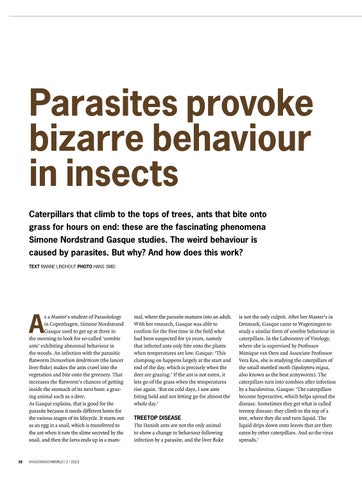Parasites provoke bizarre behaviour in insects Caterpillars that climb to the tops of trees, ants that bite onto grass for hours on end: these are the fascinating phenomena Simone Nordstrand Gasque studies. The weird behaviour is caused by parasites. But why? And how does this work? TEXT RIANNE LINDHOUT PHOTO HANS SMID
A
s a Master’s student of Parasitology in Copenhagen, Simone Nordstrand Gasque used to get up at three in the morning to look for so-called ‘zombie ants’ exhibiting abnormal behaviour in the woods. An infection with the parasitic flatworm Dicrocoelium dendriticum (the lancet liver fluke) makes the ants crawl into the vegetation and bite onto the greenery. That increases the flatworm’s chances of getting inside the stomach of its next host: a grazing animal such as a deer. As Gasque explains, that is good for the parasite because it needs different hosts for the various stages of its lifecycle. It starts out as an egg in a snail, which is transferred to the ant when it eats the slime secreted by the snail, and then the larva ends up in a mam-
38
WAGENINGENWORLD | 2 | 2023
mal, where the parasite matures into an adult. With her research, Gasque was able to confirm for the first time in the field what had been suspected for 50 years, namely that infected ants only bite onto the plants when temperatures are low. Gasque: ‘This clamping on happens largely at the start and end of the day, which is precisely when the deer are grazing.’ If the ant is not eaten, it lets go of the grass when the temperatures rise again. ‘But on cold days, I saw ants biting hold and not letting go for almost the whole day.’ TREETOP DISEASE The Danish ants are not the only animal to show a change in behaviour following infection by a parasite, and the liver fluke
is not the only culprit. After her Master’s in Denmark, Gasque came to Wageningen to study a similar form of zombie behaviour in caterpillars. In the Laboratory of Virology, where she is supervised by Professor Monique van Oers and Associate Professor Vera Ros, she is studying the caterpillars of the small mottled moth (Spodoptera exigua, also known as the beat armyworm). The caterpillars turn into zombies after infection by a baculovirus. Gasque: ‘The caterpillars become hyperactive, which helps spread the disease. Sometimes they get what is called treetop disease: they climb to the top of a tree, where they die and turn liquid. The liquid drips down onto leaves that are then eaten by other caterpillars. And so the virus spreads.’
